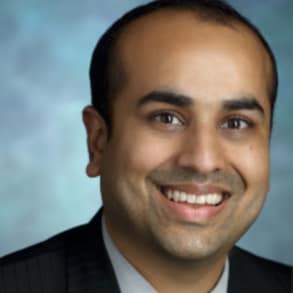Orthopaedic surgeon Amit Jain discusses common patient questions and his recent research on scoliosis, such as the cost effectiveness of bracing to shape the spine and height gain after scoliosis surgery. Lastly, Dr. Jain discusses pain control and anti-inflammatory treatment compared with opioid prescriptions for spinal surgery.
Height Gain After Spinal Fusion for Idiopathic Scoliosis: Which Model Fits Best? Cost-utility Analysis Comparing Bracing Versus Observation for Skeletally Immature Patients with Thoracic Scoliosis Opioid prescribing practices after posterior spinal arthrodesis for adolescent idiopathic scoliosis
Hi everybody. My name is um it's jane. I'm an associate professor of orthopedic surgery and neurosurgery at johNS Hopkins. I'm also chief of minimally invasive spine surgery at johNS Hopkins. It's my pleasure today to tell you a little bit about myself, our practice and our research focusing on pediatric scoliosis surgery. So first of all, my practice is rather unique because I take care of both kids and adults with a variety of spinal problems. And especially I focus a lot on Children with scoliosis. So what is scoliosis? Scoliosis is a curvature of the spine that frequently develops around childhood. When the child is transitioning into teenage years, the curvature of the spine if left unchecked and if left untreated can result in a lot of problems in the long term, including back pain, shortness of breath as well as can affect your organs such as your lungs and heart and so on. So the question becomes, can scoliosis be treated well if caught appropriately, scoliosis cannot only be treated, but it can also be reversed. And one way to reverse that is using bracing. So braces are these plastic and different kind of jackets that can basically be worn at all times to reshape the spine and do it in a way that is not invasive. So in other words, the child is wearing this jacket under their clothes and that can help reshape the spine so as the child matures and grows the spine straightens out for time. So then the question begs itself, why not prescribed racist to everybody. This is such an effective intervention. Well, there are a few reasons. And one of the reasons that races are not frequently prescribed is because the child may be too scared premature. In other words, they have already hit their growth spurt and the scoliosis is too severe. Another reason is that insurance companies don't always want to cover it. And the reason is because they're expensive. So the question then begs itself is bracing cost effective and that's what we wanted to study as part of our research. So we looked at cost effectiveness of bracing in scoliosis care. We looked at a very sophisticated statistical model called monte Carlo simulation and applied that to a housing hypothetical patients. And what we found was that bracing was rather cost effective and really saved money for the insurers. But on top of it was also something that would improve the quality of the life of the child and over a lifetime would result in prevention of surgery. So, really a very important intervention. Another question I frequently get from families who need scoliosis surgery to treat the scoliosis is am I gonna get taller? Am I going to gain height after surgery? So imagine you go into surgery a certain height and you wake up a little taller because you were able to get your spine straightened. So that's what we looked at. We wanted to answer this question. We looked at our last several 100 patients who had scoliosis surgery. And then we looked at the data and what we found was on average there was about a one inch gain in height, almost three centimeters gain in height after surgery. So that's pretty remarkable. We also looked at different mathematical models that would help explain what could predict the gain in height. And we found that some models work better than others. But on average it was about an inch gain. Finally, another common question I get from families is what about pain control after surgery? Because as you can imagine, opioids may be necessary to help control the pain, especially in the hospital phase. But what about when you go home? Well as the world has transitioned away from opioid based medicines and really the focus has become on prevention on opioid addiction. We have started to change our practices and over the years traveling to transition the kids earlier away from opioids and more towards and said, which is anti inflammatory medicines and other kinds of medicines which can be effective at treating pain but are not opioid containing. And that's what we looked at. We looked at what how have our practice patterns changed over the years. And what are the patterns in opiate prescribing practices? And what we found is that from the beginning of the study period to the end of the study period, The opioid practice prescriptions reduced dramatically. So now the kids instead of receiving on average, 57% renewal's on their opiate prescriptions only about received one in three renewals on their opiate prescriptions. So in other words, both the doctors were shying away from prescribing opioids after surgery, but the kids were able to be effectively maintained in terms of their pain control without prescribing opioids. At johns Hopkins, we are very blessed to have a phenomenal team of physicians, nurses and staff who are really passionate and dedicated to take care of Children with scoliosis, and we would be an honor for us to take care of your patients. Thank you very much.



